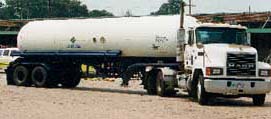Ammonia Refrigeration eTool
Receiving and Storage » Ammonia Receiving Operations

Ammonia is delivered by an outside source, such as a rail car, over-the-road tank car, or cylinder. Pumps, compressors, or simply differential pressure is used to transfer the ammonia to the storage vessels (or other portions of the system). Release of ammonia occurs as a result of improper:


Potential Hazard
- Release of ammonia during loading and unloading operations.
Possible Controls
-
Provide employees with information pertaining to the hazards of ammonia. [29 CFR 1910.119(d)(1)]
-
For more information see Properties of Ammonia.
-
-
Use hoses that are designed according to generally accepted good engineering practices. [29 CFR 1910.119(d)(3)]
-
Conduct a process hazard analysis on the loading/unloading process. [29 CFR 1910.119(e)]
-
Develop and implement written standard operating procedures (SOP) for loading the storage vessel. [29 CFR 1910.119(f)]
-
Use wheel chocks to prevent the vehicle from moving during unloading operations.
-
Wear appropriate Personal Protective Equipment (PPE) while connecting, disconnecting, and venting the transfer hose.
-
See General Safety: PPE for more information.
-
-
Never leave the charging operation unattended. [HM-225A: Safety Standards for Unloading Cargo Tank Motor Vehicles in Liquefied Compressed Gas Service. Department of Transportation.]
-
-
Ensure employees are trained in the loading process. [29 CFR 1910.119(g)]
-
Do not overfill the vessel during loading.
-
Check the level measurement device on the storage tank to ensure adequate storage space to receive the ammonia before starting unloading operations.
-
Properly connect and disconnect hoses.
-
Properly empty and vent hoses and pressure relief valves before disconnecting.
-
Do not stand in line with ammonia discharge while venting pressure relief devices and hoses.
-
Ensure proper handling, stowing, and care of hoses.
-
Disconnect and secure both ends of the hoses before moving the tank truck.
-
When loading from cylinders:
-
Properly connect and disconnect lines.
-
Properly empty and vent lines before disconnecting.
-
Properly secure cylinders.
-
-
Use bleeder valves to ensure that there is minimal vapor (no positive pressure) and no liquid ammonia in the hoses before disconnecting.
-
-
Conduct routine inspections and testing for hoses as part of a Mechanical Integrity Program. [29 CFR 1910.119(j)]
-
Investigate accidents and near misses that could have resulted in a release of ammonia. [29 CFR 1910.119(m)]
-
Establish and implement an emergency action plan in case of release. [29 CFR 1910.119(n)]
-
See Emergency Response for more information.
-
Additional Information
-
Safety Standard for Refrigeration Systems. ANSI/ASHRAE 15-2001, (2001). This document specifies safe design, construction, installation and operation of refrigerating systems. This establishes safeguards for life, health and property and prescribes safety standards. This applies to new installations and modifications of existing installations. See the Table of Contents.
-
IIAR Process Safety Management Guidelines for Ammonia Refrigeration. International Institute for Ammonia Refrigeration (IIAR), (1998). Provides and overview of OSHA's Process Safety Management (PSM) Standard. See the Table of Contents.
-
A Guide for Developing a Training Program for Anhydrous Ammonia Workers. National Institute for Occupational Safety and Health (NIOSH) Publication No. 79-119, (1978). Primarily emphasizes safety in the operation of facilities that handle anhydrous ammonia for agricultural purposes; however, the information included should interest all who handle anhydrous ammonia at other permanent installations. See the Table of Contents.

Once the transfer is complete, workers must perform standard shutdown operations to turn off the pumps or compressors, and to disconnect the hoses.
Potential Hazards
-
Release of ammonia as a result of improper procedures associated with:
-
Opening and draining process equipment.
-
Locking out equipment for maintenance.
-
Blocking liquid ammonia lines and equipment; this is particularly important for equipment which contains ammonia liquid that is below ambient temperature.
-
Possible Controls
-
Provide ammonia relief systems designed and installed according to generally accepted good engineering practices. [29 CFR 1910.119(d)(3)]
-
Provide written procedures [29 CFR 1910.119(f)] and training [29 CFR 1910.119(g)] for lockout/tagout, opening and draining process equipment, and blocking liquid ammonia lines.
-
Investigate accidents and near misses that could have resulted in a release of ammonia. [29 CFR 1910.119(m)]
-
Establish and implement an emergency action plan in case of release. [29 CFR 1910.119(n)]
-
See Emergency Response for more information.
-
Additional Information
-
Safety Standard for Refrigeration Systems. ANSI/ASHRAE 15-2001, (2001). This document specifies safe design, construction, installation and operation of refrigerating systems. This establishes safeguards for life, health and property and prescribes safety standards. This applies to new installations and modifications of existing installations. See the Table of Contents.
-
Mechanical Refrigeration and Air-Conditioning Installations Aboard Ship. American National Standards Institute (ANSI) and American Society of Heating, Refrigerating and Air-conditioning Engineers (ASHRAE) 26-1996, (1996). Provides the minimum general requirements for the design, construction, installation, operation, inspection, and maintenance of mechanical refrigeration and air-conditioning equipment aboard shipsto permit the safe, efficient, and reliable operation of such systems. See the Table of Contents.

